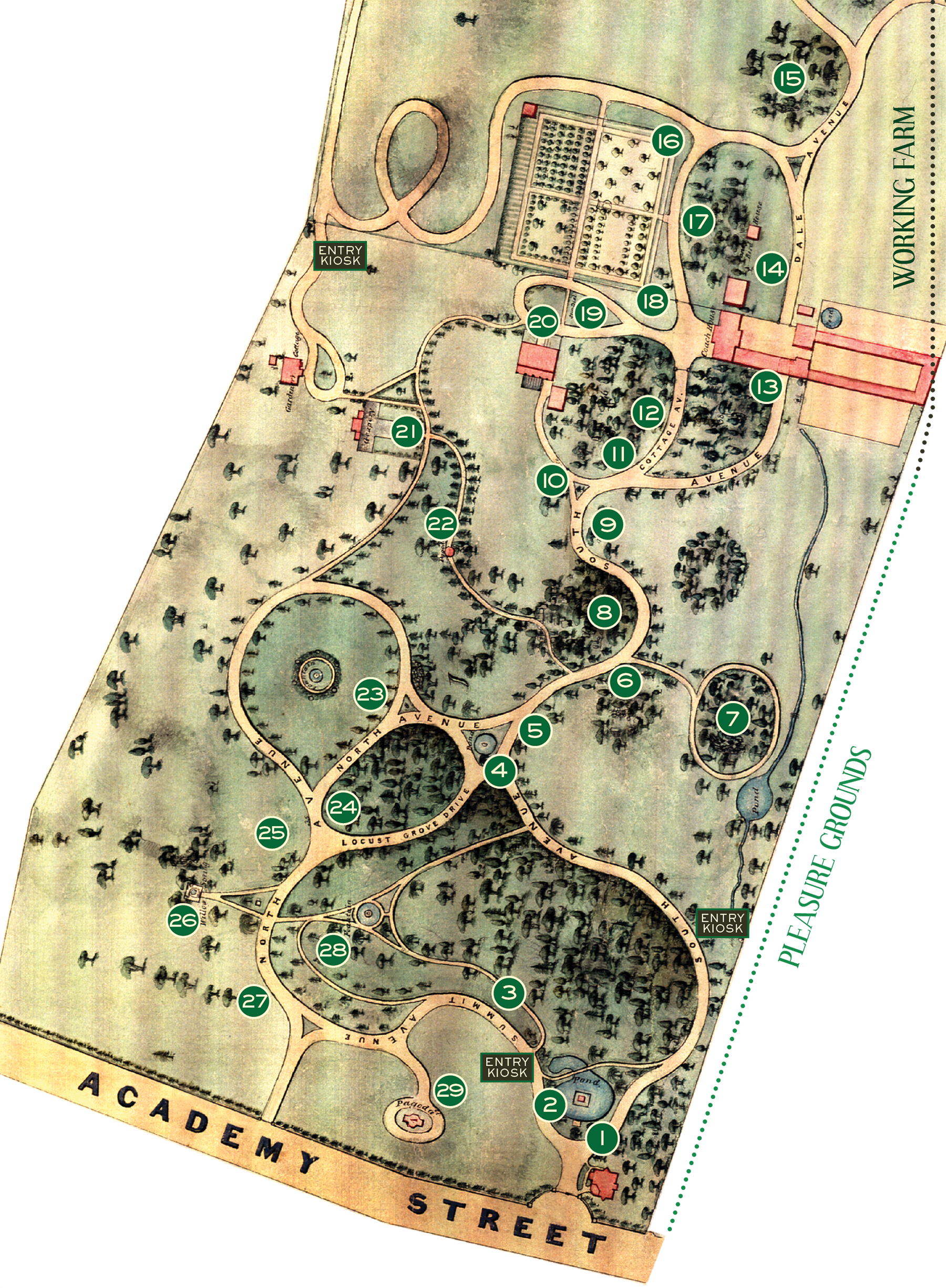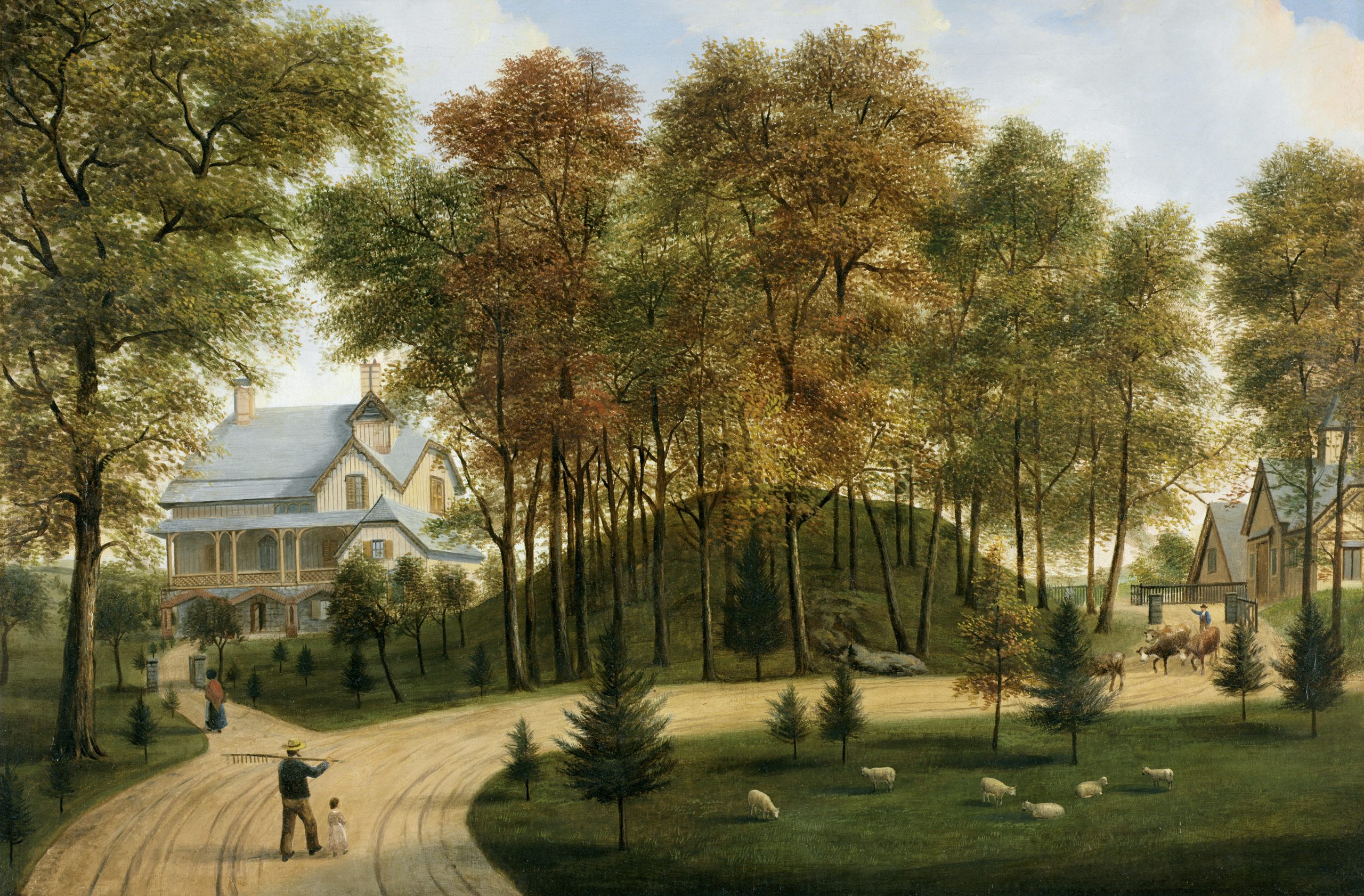
As best-selling author of A Treatise on the Theory and Practice of Landscape Gardening, Andrew Jackson Downing had enormous influence on 19th century landscape design. The son of a Newburgh, New York nurseryman, Downing became the spokesman for a new era in American taste, and his ideas transformed the appearance of the American countryside.
Downing’s aesthetic ideas stemmed from the Romantic movement that dominated artistic output from the late 18th century to the mid-19th century in Europe and America, encompassing fine art, literature, music, and philosophy. Downing believed a formalized, geometric landscape was inappropriate for the rugged Hudson River Valley terrain and promoted instead a scenographic landscape that was naturalistic in design.
Downing’s design of Springside illustrates his principles of the Beautiful and Picturesque in harmony. Characteristics of the Beautiful are found in the graceful, flowing lines of the landscape such as the meandering carriage paths, rounded forms of mature trees, open meadows, and gently rolling hills. In contrast, Picturesque elements are rugged and irregular, and as Downing put it, “spirited”, which are found in the jagged rock outcroppings and gnarled trees.
At the same time of Springside’s development, Downing transformed the National Mall into the first landscaped public park using the same principles of informal, romantic arrangements of circular carriage drives and plantings of rare American trees. Examples from Downing’s National Mall design can be found at Springside, such as the circular meadow in the Parade of President’s Park, the curving trails throughout Monument Park, and the arrangement of trees in Evergreen Garden. Downing’s design for the National Mall endured until 1934, when it was restored to Pierre L’Enfant’s 1791 plan. Downing, considered the father of American landscape architecture, also designed the White House and Capitol grounds.
Throughout Springside, Downing crafted a series of spaces or outdoor “rooms” that are approached from a constantly changing perspective of curving trails and carriage roads. Many of the landscape features that Downing pioneered at Springside were later important for Calvert Vaux and Frederick Law Olmsted in their designs for Central Park and other major parks in American cities.
The Springside Walking Tour is funded in Part by a Grant from the Hudson River Valley Greenway, and is based on Benson J. Lossing’s account of Springside from his 1867 publication, Vassar College and Its Founder. Springside Landscape Restoration gives special thanks to actor and educator Carol Lynn Gnojewski for providing the voiceover narration for the audio tour.

Springside is a 20-acre designed landscape and historic site that was once the country estate of Matthew Vassar and is the only landscape of Andrew Jackson Downing to survive largely intact. An enduring testament to both the genius of Downing and the generosity of Vassar, Springside was named a National Historic Landmark in 1969 and is a site on the Hudson River Valley Greenway Trail.
Matthew Vassar, the wealthy, local brewer and founder of Vassar College, purchased Springside as a possible site for Poughkeepsie’s rural cemetery. When citizens selected another site a mile away along the Hudson River, Vassar proceeded to make Springside his country home. In 1850, Vassar commissioned Andrew Jackson Downing and his associate, Calvert Vaux, to provide plans for the estate’s buildings and an appropriate landscaped park.
From 1850 until his untimely drowning in the Henry Clay steamship disaster along the Hudson River, Downing worked with Vassar to create a model “ferme ornee” (ornamental farm) – combining the beauty of a landscape garden with the utility of a working farm. Springside was completed in 1852 and used as Vassar’s summer estate until his death in 1868.
Springside originally included a gardener’s cottage, where Vassar lived, as well as barns and other outbuildings. Although many of the architectural treasures at Springside are in ruin, what remains is the landscaped area known as the “pleasure grounds”. A stroll along its carefully-planned carriage trails reveals rocky knolls, sunlit meadows, shaded glens, and bubbling springs all elegantly incorporated into Downing’s design.

After Vassar’s death in 1868, subsequent owners of Springside kept the house and grounds almost exactly as it had been since its inception, but by the mid-20th century, the property had fallen into disrepair. Over time, vandalism, arson, and neglect destroyed all but one of Springside’s buildings, and there was a great deal of pressure to develop the land, build a school, or otherwise dismantle the estate. These plans were finally defeated when local preservationists succeeded in having the site named a National Historic Landmark in 1969.
Springside Landscape Restoration (SLR) was organized to acquire, protect and restore the landscape. Formed in 1984, as the result of a compromise agreement with a developer, SLR was officially established in 1986 and deeded the property in 1990.
Although a National Historic Landmark, SLR does not receive any operating support from New York State or the Federal Government. An all-volunteer not-for-profit 501(c)3 organization, SLR relies on the generosity of donors to help maintain the landscape and built structures. The organization’s preservation efforts are guided by a management and maintenance plan, the Springside National Historic Landmark Master Plan, 1989 and a subsequent update.
Although volunteers face continuing challenges with increased storms, insect infestations, invasive plants, vandalism, dumping, and urban stormwater run-off, today, visitors can still experience Downing’s winding carriage trails and narrow paths curving around Springside’s series of carefully composed scenes – some sunny and serene, others brooding and romantic. Vassar took great pride in Springside, fondly naming each of these landscape features as you will learn more about when you stroll through the “pleasure grounds” as visitors once did over a century ago.

SITE LOCATION:
185 Academy Street
Poughkeepsie, NY 12601
845.454.2060
HOURS:
Dawn Until Dusk
Join our mailing list to receive news about upcoming events and updates about Springside!

The Springside Walking Tour is funded, in part, by a grant from the Hudson River Valley Greenway.
The land that now comprises Springside is part of the homelands of the Munsee Lenape, Indigenous peoples who have an enduring connection to this place.
©2025 Springside Landscape Restoration.
All rights reserved.
Springside Landscape Restoration, a 501c3 not-for-profit organization, owns and stewards Springside.
Mail to: P.0. Box 4915, Poughkeepsie, NY 12602